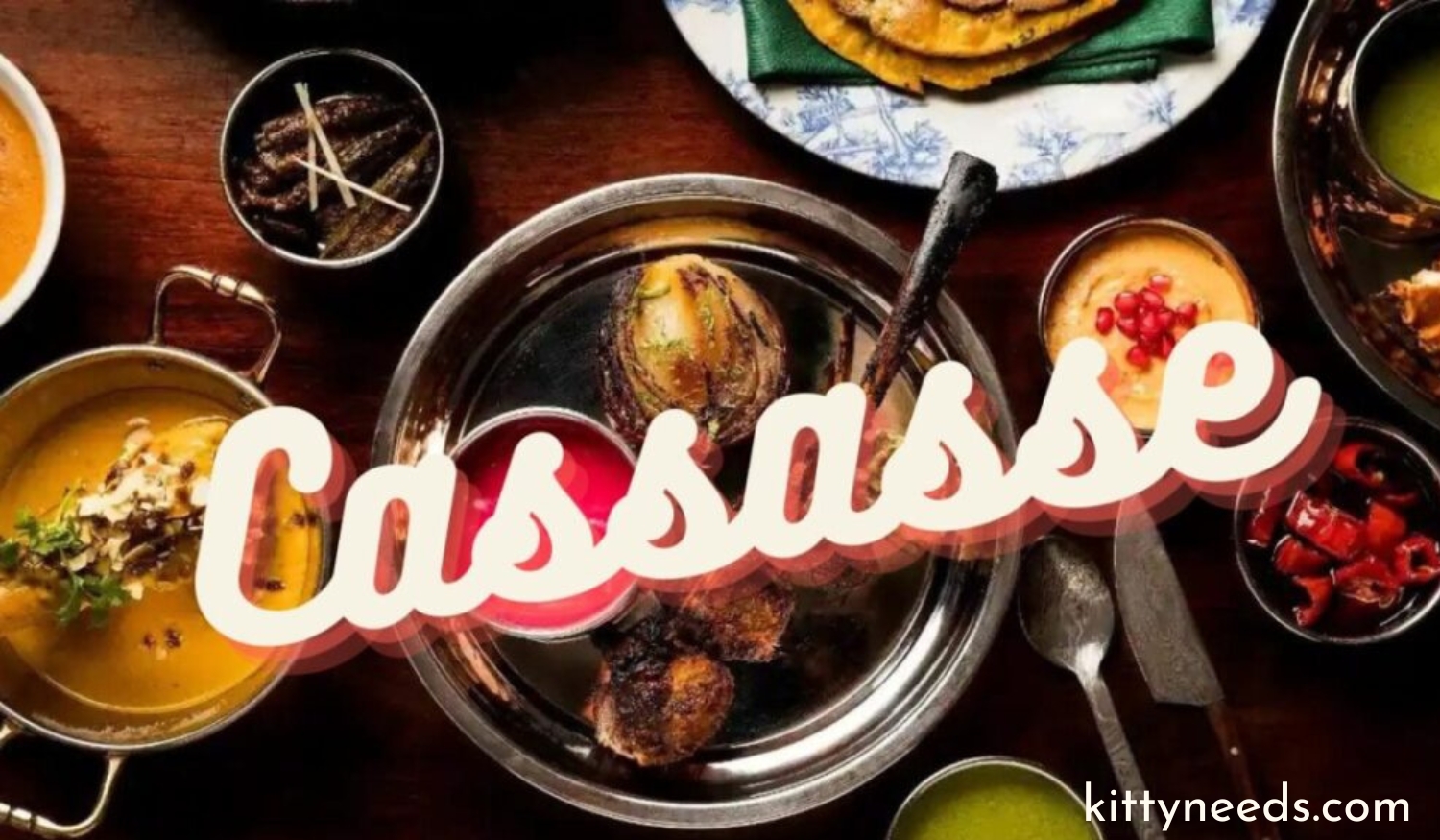Entertainment
Cassasse: A Flavorful Journey through Caribbean Delight

Cassasse
When it comes to the heart and soul of Caribbean cuisine, few ingredients hold as much significance as cassava. This tuberous root, known for its neutral yet unique flavor profile, serves as a staple in the kitchens of the islands, bringing a sense of comfort and tradition to each dish it graces. From the warm shores of Jamaica to the vibrant coasts of Trinidad, the story of cassava is one steeped in history, culinary prowess, and an unwavering connection to the people and their culture.
In this colorful narrative, we’ll peel back the layers of cassava’s roots, both metaphorically and, in some cases, quite literally, to uncover the magic behind this unassuming yet mighty ingredient. We’ll explore the historical backdrop against which cassasse has flourished within Caribbean culture, investigate its nutritional depths, and offer a tantalizing look into the diverse ways it’s prepared and enjoyed across the islands. Buckle up, because this root is about to take you on a flavorful excursion you won’t soon forget.
Historical Background
Cassava, also known as yuca or manioc, has thrived in the warm Caribbean climate for centuries. This resilient crop dates back to pre-Columbian times, with its cultivation and consumption deeply rooted in the indigenous cultures of the region. The Arawaks and Tainos, among the first settlers of the Caribbean, are said to have brought cassasse to the islands, valuing it for its sustenance and adaptability.
A testament to the significance of cassasse in Caribbean history is the establishment of the cassava bread industry on the tiny island of Carriacou in Grenada, where the tradition of making cassava bread has survived hundreds of years, maintaining its original technique and building its reputation as a local specialty.
Nutritional Value
cassasse is more than just a culinary centerpiece; it’s a nutritional powerhouse too. Rich in carbohydrates and a good source of dietary fiber, the humble cassasse offers a substantial energy boost. Surprisingly, cassava also packs a punch in the vitamin C department, with a single serving delivering a significant portion of your daily requirement.
This sturdy root also supplies valuable minerals such as manganese, magnesium, and copper, which are essential for maintaining good health. While some caution is advised with the consumption of cassasse due to its cyanogenic glycosides content, proper preparation methods effectively neutralize this compound, making cassasse a delicious and safe addition to a balanced diet.
Culinary Uses
The versatility of cassava in the Caribbean kitchen knows no bounds. It’s used to create everything from hearty stews to delicate side dishes. Dried and crushed into hearty ‘farines,’ used as a thickening agent, boiled for soups and stews, or fried to create a crunchy and satisfying snack, cassava’s applications are as varied as they are essential.
However, one of the most celebrated uses of cassava is undoubtedly the delectable casareep – a sauce made from cassava that is an indispensable ingredient in the national dish of Guyana, Pepperpot. This spicy and richly flavored meat stew owes its unique taste and texture to the slow reduction of cassava juice into a thick, molasses-like syrup, testament to cassava’s culinary prowess.
Cooking Techniques
Preparing cassava requires patience and a good understanding of technique. The roots are tough and require careful cleaning and peeling to remove the bitter, protective skin. Once peeled, cassava can be boiled, steamed, or roasted to tenderness, at which point it’s ready to soak up flavors and contribute its distinct texture to dishes.
One particularly cherished method of preparing cassava in the Caribbean is ‘cassareep-ing,’ a term coined cheekily from the process of making casareep. It involves grating the cassava, squeezing the pulp through cheesecloth to extract the liquid, and then allowing the liquid to reduce to form cassareep, typically employed as a seasoning and preservative in various dishes.
Flavor Profile
cassasse is often described as having a slightly nutty, almost sweet flavor that pairs well with a broad range of seasonings and ingredients. Its texture, when prepared correctly, can be dense and starchy, offering a delightful contrast to the softer components in a dish. Whether it’s the star of the show in a cassava pone or supporting role in a savory stew, cassava’s layered taste profile adds depth to any culinary composition.
The neutral nature of cassasse also means it can adapt to take on the characteristics of the flavors it’s cooked with, making it a versatile canvas for culinary creativity. This chameleon-like ability to assimilate and uplift other tastes is part of what makes cassava such a beloved and indispensable component in Caribbean cooking.
Local Varieties
The Caribbean boasts a rich tapestry of cassasse varieties, each with its own unique qualities. From the smooth-skinned, bone-white Bahamian cassasse to the vibrant purple hues of the Dominican yuca morada, there’s a variety for every palate and every dish. Cultural preferences and traditional recipes play a significant role in the selection of which type of cassava to use, with some varieties holding a special place in local folklore and customs.
Each variety brings its own set of attributes, from the texture of the cooked flesh to the time it takes to reach maturity, and it’s this diversity that contributes to the complex and varied landscape of Caribbean cuisine.
Recipe Showcase
Imagine this: the sun is setting over the horizon, casting a warm orange glow across the sea. You’re sitting down to a table adorned with the vibrant colors of the Caribbean, the sounds of laughter and the rhythmic sway of music in the background. The centerpiece of your meal? A serving of cassasse prepared in a traditional Caribbean style.
Here’s a step-by-step guide to creating a classic dish that captures the essence of the islands. This recipe for Cassava Dumplings in Stewed Saltfish is an example of how cassasse can be transformed into a comfort food that’s both satisfying and full of character.
Ingredients:
- 2 lbs. cassasse
- 1 lb. saltfish (salted cod)
- 1 large onion, diced
- 2-3 cloves garlic, minced
- 2 tomatoes, chopped
- 1 bell pepper, chopped
- 1 hot pepper, minced
- 1 tbsp. thyme leaves
- 1 tsp. black pepper
- 1 cup coconut milk
- 2 tbsp. vegetable oil
- Water
Instructions:
- Begin by preparing the cassasse. Peel the tough, outer skin and cut the root into manageable pieces. Cut these pieces lengthwise and remove the fibrous core.
- Cube the cassasse into bite-sized pieces and rinse them thoroughly in cold water.
- Place the cassasse in a large pot and cover with water. Bring to a boil and cook until tender, about 20-30 minutes. Drain and set aside.
- Prepare the saltfish by soaking it in water overnight, changing the water several times to remove some of the salt. Boil the fish for 15-20 minutes, then drain and flake into small pieces.
- In a separate large pot, heat the vegetable oil over medium-high heat. Add the onions, garlic, tomatoes, bell pepper, hot pepper, thyme, and black pepper. Sauté until the vegetables are softened and fragrant.
- Add the flaked saltfish to the pot and stir to combine with the vegetable mixture.
- Pour in the coconut milk and add the cassasse pieces. Stir gently to mix all ingredients and coat the cassava with the sauce. If necessary, add a little water to create enough liquid to stew the cassava.
- Reduce the heat to low, cover the pot, and simmer for 10-15 minutes, allowing the flavors to meld and the cassava to absorb the sauce.
- Once the cassava is tender and the saltfish is heated through, the dish is ready to serve.
Present the stewed saltfish and cassava with a slice of avocado and a side of fresh salad for a truly authentic Caribbean dining experience.
YOU MAY ALSO LIKE
Discover Bigfoot Game Shack: Your Ultimate Gaming Community Hub
Conclusion
It’s clear that cassava is more than just an ingredient in Caribbean cuisine; it’s a symbol of cultural identity and a culinary ambassador for the vibrant flavors of the islands. Its rich history, nutritional benefits, and diverse applications in the kitchen paint a picture of an ingredient that is as robust and resilient as the culture from which it hails.
Whether you’re a seasoned chef or a newcomer to the world of Caribbean cooking, the inclusion of cassava in your culinary repertoire offers an adventure in flavors and a deeper connection with a tradition unlike any other. The next time you’re exploring the depths of your pantry, consider reaching for a hearty cassava root—it might just be the start of a flavorful and unforgettable Caribbean-inspired feast.
Frequently Asked Questions
- What is cassareep and how is it made?
Cassareep is a thick, dark liquid made from the juice of cassava root. It’s prepared by grating the cassava, extracting the juice through cheesecloth, and then simmering the liquid until it reduces to a syrup-like consistency. Cassareep is commonly used as a seasoning and preservative in Guyanese Pepperpot and other Caribbean dishes.
- Can cassava be eaten raw?
No, cassava should not be eaten raw due to the presence of cyanogenic glycosides, which can release cyanide when digested. Cooking cassava thoroughly removes these compounds, making it safe and delicious to consume.
- What are some popular cassava varieties in the Caribbean?
The Caribbean is home to multiple cassava varieties, including the smooth-skinned, bone-white Bahamian cassava and the yuca morada, known for its vibrant purple hue. Each variety’s unique texture and flavor lend themselves to different traditional dishes.
- How do you make Cassava Dumplings in Stewed Saltfish?
Begin by preparing and boiling bite-sized cassava pieces until tender. Prepare saltfish by soaking and boiling it to remove excess salt. Sauté onions, garlic, tomatoes, peppers, and spices, then add the flaked saltfish and cassava pieces, followed by coconut milk. Simmer until the cassava is tender. Serve with avocado and fresh salad on the side.
- Why is cassava significant in Caribbean cuisine?
Cassava holds a special place in Caribbean cuisine due to its versatility, rich history, and nutritional value. It has been a staple food for centuries, utilized in both savory and sweet dishes. Cassava is not just an ingredient; it’s a symbol of cultural identity and resilience in Caribbean culinary traditions.

-

 Pets and Animals7 months ago
Pets and Animals7 months agoShovel Dog: Everything You Need to Know
-

 Pets and Animals7 months ago
Pets and Animals7 months agoHow To Trim Dog Nails: A Step-by-Step Guide for Painless Pups and Peace of Mind
-

 Pets and Animals7 months ago
Pets and Animals7 months agoHow Often Do You Take A Cat to the Vet? A Guide for Caring Owners
-

 Pet Care Guides7 months ago
Pet Care Guides7 months agoGive a Loving Home: Adopt a Pet, Change a Life with Pet finder
-

 Pet Care Guides7 months ago
Pet Care Guides7 months agoThe Definitive Guide to Rimadyl Carprofen Dogs: Uses, Dosage, and Safety
-

 Other7 months ago
Other7 months agoHow to Hello kitty drawing: A Step-by-Step Guide for Fans of All Ages
-

 Pets and Animals7 months ago
Pets and Animals7 months agoBubonic Plague case oregon cat: A Modern Tale of Medieval Disease
-

 Pet Care Guides7 months ago
Pet Care Guides7 months agoHere’s Why Nationwide Pet Insurance Should Be on Your Radar